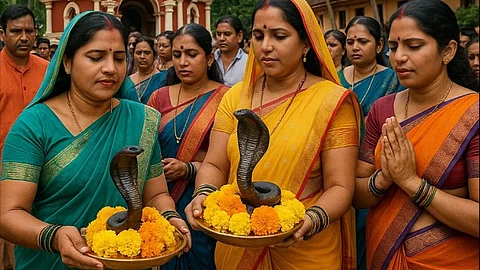

Observed across India during the month of Shravan (July–August), Naag Panchami is more than just a religious ritual—it is a profound expression of reverence for nature, symbolized through the worship of snakes. Rooted deeply in Hindu mythology and cultural heritage, the festival honours serpent deities, known as Nagas, believed to offer protection and blessings of health, prosperity, and harmony.
Traditionally, devotees offer milk, flowers, and durva grass to snake idols or, in some places, to living cobras. These offerings are believed to purify the soul, ward off snakebites, and bring divine grace. Despite growing awareness of animal welfare—especially concerns that snakes are often forced to consume milk, which can be harmful to their health—the ritual continues, deeply embedded in cultural sentiment.
According to Hindu lore, serpent deities guard Earth’s treasures and play significant roles in mythological tales. Vasuki, the king of snakes, is said to have helped churn the ocean during the Samudra Manthan to extract the nectar of immortality. Another tale recounts Lord Krishna’s subduing of the venomous Kaliya Naag, promising protection to Gokul’s people. Snakes are also revered as ornaments of Lord Shiva and associated with Lord Vishnu, who rests on the eternal Shesh Naag.
In Goa, Naag Panchami is observed with distinctive regional traditions. “In Goan households, people refrain from digging the Earth on this day, respecting the serpents’ habitats,” shares Apurva Kankonkar. “Clay idols of Naag are worshipped, and traditional sweets like patolleo—a steamed rice dumpling stuffed with coconut and jaggery wrapped in turmeric leaves—are prepared and offered”
Celebrations often include age-old family customs. Radiya Mahale from Mala, Panjim, shares, “We still worship an old nag murti passed down from my grandmother’s time. We offer it milk and lahyo (puffed rice). For us, Naag Panchami isn’t complete without making patolleo.”
In South Goa’s Navelim, Pankaj Kamble explains the agricultural significance: “During the monsoons, snakes emerge from their pits and help protect crops by controlling rodents. Worshipping them is a form of gratitude. Some even leave patolleo in the fields as offerings to the snakes, hoping to avoid harm.”
This sacred day is not only a celebration of mythology and faith but also a symbolic reminder of the harmony that must exist between humans and the natural world. Naag Panchami continues to be a festival where spiritual devotion meets ecological reverence, particularly in regions like Goa where cultural and environmental consciousness go hand in hand.